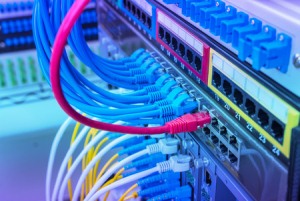As the world goes wireless, Indi Sall, technical director, NG Bailey’s IT Services division asks if the days of the wired network are numbered. Compared to a few years ago, plugging things in has started to feel like a major hassle.
In the home environment the wireless smart hub has become the centre of the digital home, connecting smart TV’s, wireless speakers, wireless printers, lighting, power and heating controls, and providing a platform for voice assistants such as Siri and Alexa. This wireless environment is also becoming increasingly visible in the corporate world with networks now supporting all of the above in addition to applications such as united communications and wireless conferencing solutions etc.
Wireless networks have had such a positive impact on the user’s digital experience that it is now impossible to imagine life without them. Does this mean that the time has come to abandon wires altogether?
In terms of throughput speed and continuity – two of the pillars by which today’s corporate networks are judged – the answer should be a plain ‘no’. Here, the wired world still reigns supreme. When considering flexibility, however, cables don’t just falter, they fall by the wayside completely. Have you ever seen anyone plug a cable into their smartphone so they could get faster Internet? Me either.
The proliferation of the Internet of Things (IoT) has led to an increase in network connected devices. As sensors gradually appear in everything, from the clothes we wear to the chairs we sit on, our already-substantial reliance on wireless data is about to spike. Then there really is no going back.
Couple IoT with today’s increasing business appetites for cloud services and workforce mobility, then combine it with end-users’ insatiable consumption of streamed and social media, and it’s easy to see the growth in wireless connectivity and the need for investment in the latest wireless technologies in order to cope with demand.
Over the next three years, these forces will drive a huge upswing in demand for technologies that can optimise wireless infrastructure performance. Many owners of tenanted and high-occupancy buildings, in particular, are having to completely rethink their entire approach to ensure their estate offers state of the art digital connectivity.
Not only must building owners consider Wi-Fi technologies but they must also consider optimising the macro GSM network to ensure excellent 4G cellular coverage. Distributed antenna systems (DAS), which boost 3G and 4G network signals inside a property, are starting to gain serious traction.
By enabling greater in-building availability of mobile operator services, DAS signal boosters can offset the ‘blocking effect’ that many buildings’ physical structure has on GSM signal coverage, overcoming the common ‘poor mobile signal’ problem that many occupants of large buildings experience.
WiFi is also evolving. Increasingly good quality WiFi is being seen as a utility service within public buildings such as universities, hospitals, shopping centres, hotels, transport estates and town centres. Smart public Wi-Fi systems, like the SSE Arena in Belfast, not only transmit zone by zone high-density Wi-Fi signals that enable entire crowds to connect with 50Mbps plus speeds, but they also offer patrons a personalised experience with the ability to digitally purchase merchandise, targeted advertising and way finding or location services.
Services like these, are enabling physical venues and stores to compete with the on-line shopping experiences offered by the likes of Google and Amazon.
As the wireless radio spectrum becomes increasingly crowded, new technologies such as Li-Fi will enable new forms of data connectivity using LED light rather than radio waves, offering the potential to support even faster data speeds and capacity to support the huge expansion in the number of IoT devices, whilst providing energy efficient lighting at the same time.
Wireless gets all the attention. And with all these dazzling advances, should we still care about cables? As end-users, probably not. As guardians of the large buildings and shared spaces in tomorrow’s smart cities, however, the definitive answer has to be ‘yes’. This is because behind every headline-grabbing wireless solution is an unseen and indispensable structured cable network.
These cables might pick up wireless data from miles away (with operator 3G or 4G services, for example). They might also take on your data from right beneath your feet or a few inches above your head. Either way, it takes a tremendous amount of hard cabling to backhaul today’s wireless data – something that isn’t going to change any time soon.

This is something that we must not forget. As the networks in our buildings undergo their inevitable digital upgrade, it will pay to remember that not every cabling solution is made equal. The quality of the back-end design will determine whether future wireless technologies can be integrated and how easily they can be supported. This is why the role of specialist systems integrators is so fundamental to the future success of our smart buildings.
No one has the budget, let alone the desire, to rip and replace a brand-new system and, in the absence of global standards for structured cabling design, finding the right partner to architect as well as implement the network is crucial. The impact of getting the design wrong would be felt for years to come.
As everyday end-users of wireless technologies we can expect the gradual separation from the cabled world to continue. As this happens, however, maintaining an appreciation for the vital role that cabling plays in enabling today’s slick user experience couldn’t be more important.
Although the number of traditional data points will fall, with a huge expansion in connected devices, the infrastructure within modern digital buildings will need to be based on the latest cable standards supporting 10GB over copper and 100Gb over fibre. Now is the time when the back-end is being overhauled and it is this work that will truly make or break the future of our digital world.
The author of this blog is Indi Sall, technical director at NG Bailey
Comment on this article below or via Twitter: @IoTNow_OR @jcIoTnow










